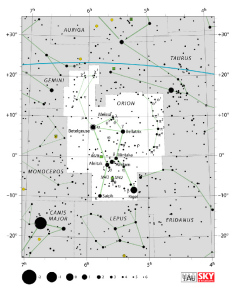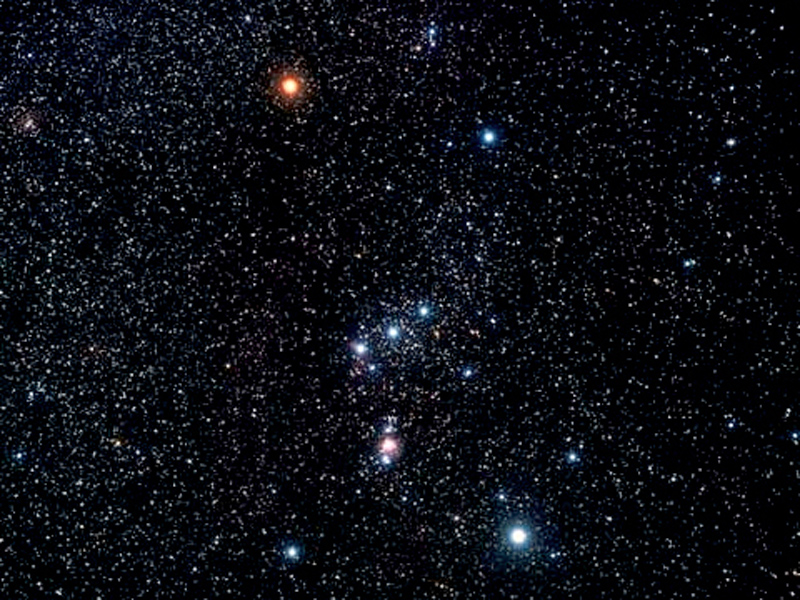The temperatures are plummeting and the winter solstice is nearly here. On those dark nights when the sky is free from clouds, the stars can seem particularly bright and clear, especially in the southern part of the sky out over Rye Bay. You might imagine this aerial clarity has something to do with the cold air freezing out all the dust and pollution from the atmosphere. Although that might be partly true, something much more remarkable is happening.
At this time of year, the planet is turned away from the very distant, hazy mass of stars that form the centre of the Milky Way, our galaxy. Instead, for the next few months, the stars that become visible in our night sky over Rye are much closer to the Earth and so appear brighter and sharper. Among all these brilliant winter stars there is one constellation that is particularly prominent and forms an easily recognizable pattern as it rises in the south east beyond Dungeness and travels through the night to set again behind Hastings.
The constellation of Orion, named after the giant hunter from Greek mythology, initially looks like a large box shape at approximately a 45 degree angle to the horizon. This grouping principally consists of four bright stars making up the corners, with a fainter fifth one at the top, making a triangle shape there. Betelgeuse, the ninth brightest star in the sky, can be found at the top left corner, twinkling with a discernible red/orange colour. Rigel, the sixth brightest star, and an important one for marine navigation, can be found at the bottom right shining with a blue tinge. In the centre of the box is a row of three stars – Alnitak, Alnilam and Mintaka – that are known collectively as Orion’s Belt, one of the easiest star configurations in the whole sky to recognise. It is useful to remember that the left-hand side of the belt points down due south.
Betelgeuse, or Alpha Orionis, one of the most famous stars in the sky, is a red supergiant, with a diameter some 1,500 times that of the sun. It is thought to have been born in a nebula – a giant cloud of ionized gas – 10 million years ago. If you consider that our own sun is estimated to be 4.6 billion years old and about half-way through its life, then, in astronomical time, this star formed only a moment ago. At the time when Betelgeuse was condensing into a flaming sphere inside that distant cloud, here on this planet the great apes were still evolving and Homo sapiens had yet to appear as a distinct species.
Betelgeuse might soon be gone. A recent estimate suggests that the star could self-destruct in a supernova explosion at any time within the next 100,000 years. It is even possible that this explosion has already happened, but we have yet to observe it here.

Looking at this star, bear in mind that the reddish light you see has taken an estimated six and a half centuries to get here. This means you are seeing the star as it was in the late 14th century, predating the construction of Rye’s original town wall s and the Landgate Tower by just a few decades. Not long afterwards a new monastery was constructed in the town on the site on Conduit Hill, where now just the large chapel building remains. The monastery became a stopping-off point where travellers setting out on the popular Way of St James pilgrimage to Santiago would stay till they could find a boat to take them to Spain. No doubt those ships would use Betelgeuse and the other stars of Orion as an important navigational aid to take them on their journey southwards.
In the next few weeks if you look southwards from Rye’s Gun Gardens after 10pm you might see an especially luminous star just below Orion, rising over the river Rother and flickering with a variety of colours, as though in sympathy with the red and green navigation beacons flashing along the river banks. This is Sirius, which is the brightest of all the stars in the sky, and one of the closest stars to our own sun, at a distance of a mere 8.6 light years away. Thousands of years ago the ancient Egyptians would see Sirius rising over the Nile just before the dawn in summer and know that the time for the annual flooding of the great river was due any day soon after. They would look to Sirius and Orion in the night time and see their own gods and goddesses in these stars. In Orion’s Belt they would see a place where the Pharaohs would travel after death.
If, after gazing southwards, you turn towards the east, you will see Jupiter low on the horizon, currently 452 million miles away from the Earth, and brighter than any of these stars. Should you be able to point a telescope at this huge gas-giant planet, you might be fortunate enough to see some of its largest moons, such as Io, Ganymede, Europa and Callisto. When Galileo first directed his telescope towards Jupiter in 1610 he was able to see these four as yet unnamed moons and to trace their orbits around the planet. These observations led him eventually to his conclusion that the Earth was not at the centre of the universe, as the religious orthodoxy of the time insisted. Now, 400 years after he was forced to recant these heretical views before a church court, we know that there are in fact 67 moons in orbit around Jupiter.
Orion currently rises at about 7pm at 120 degrees SE and sets at about 6am at 260 degrees SW.
And now the question everyone asks: how do you pronounce Betelgeuse? Like all the star names in Orion, Betelgeuse is derived from Arabic. The most common western pronunciation is BET-el-jooze. It is often referred to in popular culture as Beetle Juice. An interesting article tracing the etymology of the name can be found here.
Orion photograph by Akira Fujii and reproduced by kind permission of David Malin – http://www.davidmalin.com



